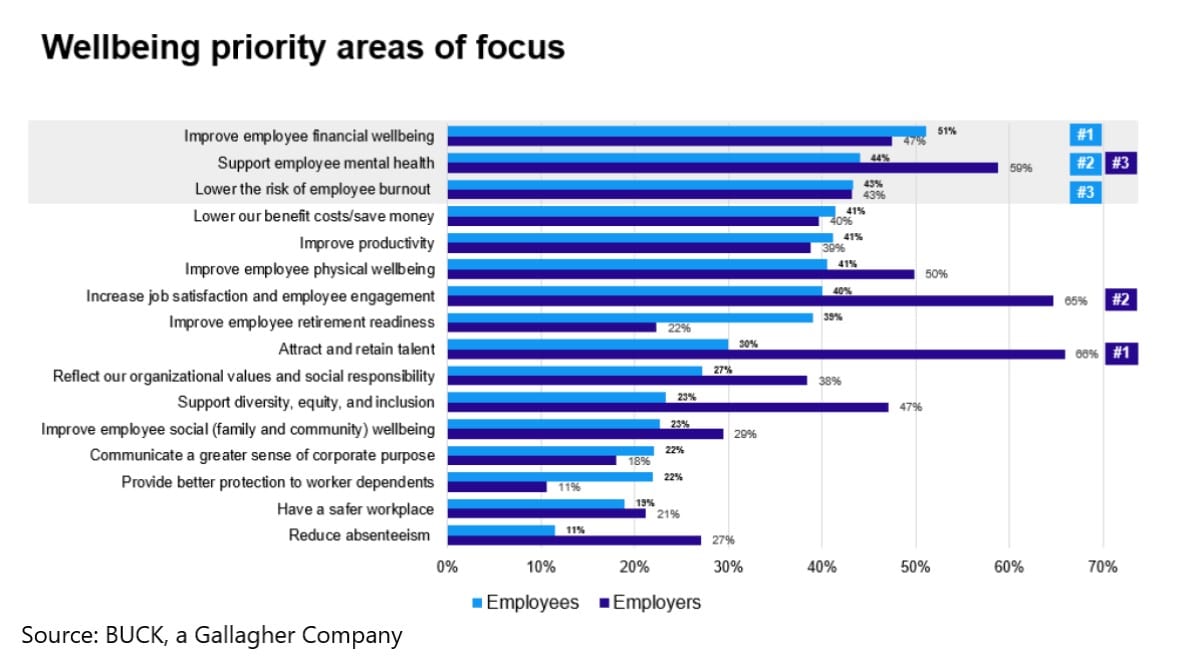Even though employee wellbeing has increasingly come into the spotlight in recent years, many employees still feel their employers aren’t investing in the benefits that could really support their wellbeing, according to a new report from human resource consulting firm Buck.
In Buck’s 2024 Wellbeing and Voluntary Benefits Survey—which queried 255 large U.S. employers and 698 employees—when asked about their priorities for employee wellbeing, there were some stark contrasts between employer and employee perspectives. Leaders, for instance, cited attracting and retaining top talent and driving employee engagement as their top means of strengthening employee wellbeing. Meanwhile, workers themselves appear more focused on their day-to-day needs, such as financial wellness and mental health.
In a tight labor market, that disconnect in employee wellbeing is something HR should be keenly aware of—especially given that 63% of employees would change jobs for better benefits, according to Buck’s report.
One issue that could be driving the divide on employee wellbeing, experts say, is insufficient benefits communication: Seventy-four percent of employers note they intend to increase their commitment to employee wellbeing in the next one to three years, but only 50% of employees say they’ve seen such an increase so far. Currently, 55% of employees say they do not understand their benefits, adds Tom Kelly, a principal in the health practice at Buck.
Kelly notes that—in addition to aligning benefits offerings with employee needs—clear and thorough communication about available benefits is key to helping workers feel their wellbeing priorities are being addressed.

How to close the divide on employee wellbeing priorities
Although research has found strong ties between positive employee wellbeing and improved employee engagement and attrition, a recent report from employee engagement platform provider Reward Gateway found that just 40% of employees think their companies are doing a good job supporting employee wellbeing.
Kelly offers several benefits areas where HR can focus to help their employer meet employees’ wellbeing priorities.
Financial wellbeing
Employees’ No. 1 wellbeing focus is improving their financial health, cited by 51% of employees as a priority. But for employers, it ranks No. 4.

The survey found that 92% of employees want additional financial resources from their employer, up from 79% in 2022. Additionally, 58% of workers live paycheck-to-paycheck, and one in three say they cannot afford a $500 unexpected expense.
Research has found that financial wellbeing is particularly critical to younger workers, including millennials, who represent the largest segment of the workforce.
Kelly advises that, given today’s multigenerational workforce, HR should consider generational differences in benefits design to ensure relevance across generations.
“For younger employees, there is a direct correlation with greater interest in financial wellbeing benefits, mental health and support for dependent care,” says Kelly. “So, organizations need to be looking at their population differently today in terms of how they appropriately address wellbeing.”
Dependent care
Buck found that 22% of employees list better support for their dependents as a wellbeing priority, but only 11% of employers cite that as a top focus.
To help bridge that divide, Kelly says, employers can consider benefits offerings like tuition reimbursement, childcare assistance, employer-subsidized life insurance, and support for new parents, such as breastfeeding classes and post-partum care. These are offerings that are increasingly becoming important to the workforce: In 2022, half of the employees surveyed by Buck wanted more offerings that help them support their families, a figure that now stands at 70%.
“Millennials represent 40% of the workforce, the largest segment of the workforce that now identifies as parents,” says Ruth Hunt, a principal in employee engagement and communication at Buck. “So, the whole issue of family and dependent support is a hot topic.”

Retirement readiness
Improving employee retirement readiness is another area where there is a disconnect, with 39% of employees noting this is a priority and 22% of employers feeling likewise, according to the survey.
According to the survey, Baby Boomers value retirement readiness and consider it among the top benefits they would like to receive. This year, employees can make $23,000 in pre-tax contributions to their 401(k) savings accounts, up 2.2% from the previous year.
One way HR can help employees save for retirement is by offering auto-enrollment into 401(k) plans, Craig Reid, president of Marsh McLennan Agency’s retirement planning services business MMA Securities LLC, said in a previous interview with HRE. Reid says more than 85% of employees who are auto-enrolled in retirement savings programs continue to contribute.
He advises employers to start with deductions of 8%-10%—compared to the standard 6%—and add an auto-escalation feature that increases an employee’s contribution by 1% each year until it reaches 15%, for example, he says.
Learn how organizations integrate employee wellbeing into their cultures at HRE’s upcoming EPIC Conference, April 24-26, in Las Vegas. Click here to register.
The post As employees call for more wellbeing support, how HR can help appeared first on HR Executive.